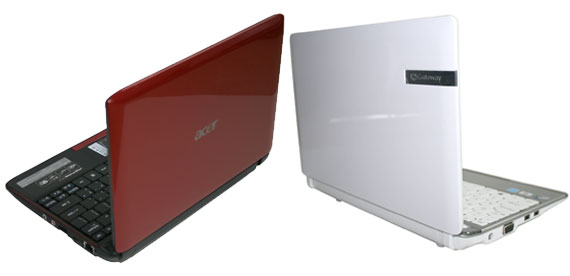Gateway and Acer Netbooks: Wonder Twin Powers, Activate!
by Vivek Gowri on April 28, 2010 2:22 AM ESTAcer and Gateway Netbooks: Typical Pine Trail
One of the biggest challenges in reviewing netbooks is differentiating between them and deciding what really separates the best in class from the also-rans. Unfortunately, with all of the performance and feature parity shared by the standard bearers, this is a really difficult task. With established hardware manufacturers like Dell, HP, Acer, ASUS, and MSI making cohesive and well-thought-out devices, the quality of design and manufacturing ends up similar, so often personal preference separates the various netbooks on paper. In practice, the only thing that differs is the quality of the screen, which is dependant on how much priority the manufacturer places on the LCD. Beyond that, there isn’t a whole lot to separate any netbook from the rest of the class.

At the end of the day, the Aspire One 532h and LT2120u are just netbooks. Solid competitors in the netbook class, but nothing mind blowing, and not really good enough to knock the ASUS Eee 1001P off its throne. They're not built quite as well and the LCD isn't near the high quality panel the ASUS uses, but the Aspire One (and Gateway clone) are still capable netbooks. I can't recommend them over the 1001P, primarily because of the LCD, but other than that the difference between them and the rest of the netbook class is pretty slight. The Acer and Gateway are both specced and priced to equal the 1001P and others, so if you prefer the Acer or Gateway brands, these are definitely up to scratch.
And of course, we would be remiss if we didn't mention where CULV machines fall in all of this. You can get a single-core CULV machine like the Acer 1410 for within $70 of the cost of these netbooks. This is true for any of the netbooks in the running—not just the Gateway and Acer, but also the Eee 1001P and everything else. Spending another $50-100 could get you a dual-core processor, but then you are paying significantly more than a netbook. If you are willing to spend a little more, you can get vastly improved performance and features, but with less battery life and a higher cost.










15 Comments
View All Comments
Lonyo - Wednesday, April 28, 2010 - link
Is there any news on what Pinetrail can be used for?Are there going to be 11.6" / 1366x768 Pinetrail netbooks? Or indeed any 1280x720 10" netbooks with Pinetrail.
All these 1024x600 screens are not particularly enticing, and it's higher resolutions which really give some appeal (plus 11.6" chassis mean a bigger keyboard, which is nice if you actually want to be productive, same for a higher resolution screen).
DanNeely - Wednesday, April 28, 2010 - link
Anandtech did a preview of a lenovo S10-3 with a 10" 1280x720 screen a few weeks ago. Unfortunately it's not available yet, nor is the 10" 1366x768 EEE 1005PR.Vivek (AnandTech) - Wednesday, April 28, 2010 - link
There are a few 10"ers out there with 1366x768 screens. The Dell Mini 10 and HP Mini 210 have it as an option (combined with the Broadcom HD chip). All of the forthcoming Ion 2 netbooks have wxga screens as well, as does the Asus Eee 1201 update.jabber - Wednesday, April 28, 2010 - link
Yes okay okay they are netbooks but at least give us a little more screen depth!CSMR - Wednesday, April 28, 2010 - link
Very good review.But I disagree that higher brightness is better.
In specific situations (outdoors in bright light) it can be useful, but normally LCDs are too bright and you can measure benefits to users from reducing brightness. See the Eizo guide to eye fatigue:
http://www.eizo.com/global/products/flexscan/vdt/G...
strikeback03 - Wednesday, April 28, 2010 - link
Sure, but a bright screen can always be turned down, while a dim screen is dim no matter what. Given that these are netbooks and not DTRs there is a decent chance they will be used outside, and a 120 nit screen might well be unusable there. Plus color accuracy is already bad here, so any drop from dropping screen brightness isn't a big deal.strikeback03 - Wednesday, April 28, 2010 - link
The labels in the relative battery life chart are all messed up. The number labeled HP Mini 311 should be the ASUS 1005PE, the one labeled Gateway 5409u should be labeled HP Mini 311, the one labeled Dell 11z should be the Gateway 5409u, the one labeled ASUS 1201N should be the Dell 11z, and the one labeled ASUS 1005PE should be the ASUS 1201N.Qubix1 - Wednesday, April 28, 2010 - link
Relative Battery Life chart needs a look:HP Mini 311 = 5.47 m/Whr (9.48)
Asus 1001P = 9.48 m/Whr (9.42)
Acer AO532h = 7.75 m/Whr (7.75)
Gateway LT2120u = 7.48m/Whr (7.48)
Acer 1810T = 7.47 m/Whr (7.45)
Asus 1201N = 3.92 m/Whr (7.15)
Dell Inspirion 11z = 7.11 m/Whr (6.89)
Gateway EC5409u = 6.90 m/Whr (5.47)
Asus 1005PE = 9.37 m/Whr (3.95)
JarredWalton - Wednesday, April 28, 2010 - link
Sorry... I updated the spreadsheet to list the battery capacity, and then copied/pasted the labels. I thought all of my tables were in the same order, but the relative chart was jumbled and so I screwed up the labels on most of the laptops. The chart is now correct.jaydee - Wednesday, April 28, 2010 - link
Could we PLEASE see a review of an AMD-based netbook? Like the ASUS Eee PC 1201T-MU10? Should be better cpu, better graphics, bigger lcd, less battery life at a tad higher price. Anandtech even had a giveaway of a Lenovo x100e with the AMD MV-40 processor, but no review. How do these cpu's compare?!?!?Thanks!